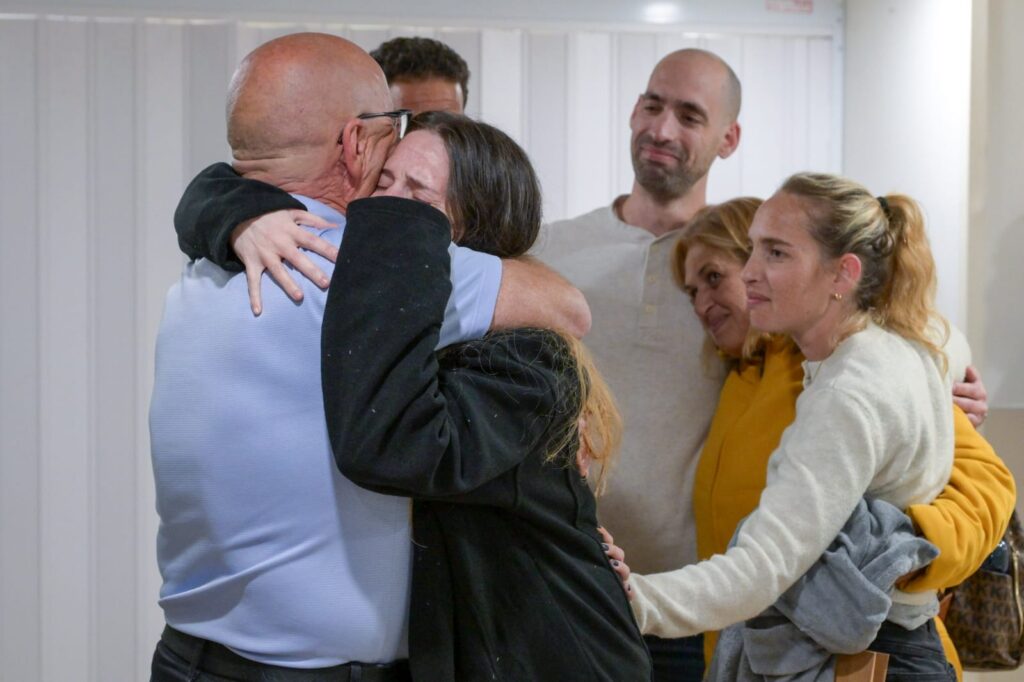
Returnee’s reunion meeting with their families, from the "Shiva-Tel Hashomer" medical center in Israel. Credit: Ma'ayan Tuaf Government Press Office, Israel.
Jerusalem/Washington/Jenin: Following the ceasefire deal between Israel and Hamas, effective from 11:15 am local time (09:15 GMT) on Sunday, January 19, 2025, several Israeli hostages have been released from captivity in Gaza, joyfully reuniting with their families after enduring over 15 months of intense conflict. The hostilities were sparked by the tragic occurrences of October 7, 2023, when Hamas initiated an assault on Israeli civilians. Throughout this tumultuous period, the toll has been staggering: at least 47,035 Palestinians have lost their lives and around 111,091 have been injured. Additionally, the Hamas-led attacks on October 7 in Israel led to the deaths of at least 1,139 individuals, with more than 200 taken as hostages.
However, the Ceasefire Deal is only temporary, as Israeli Prime Minister Benjamin Netanyahu revealed. With the Gaza ceasefire holding, Israeli Defense Forces (IDF) today began an extensive and significant military operation to defeat terrorism in Jenin in the West Bank– ‘Iron Wall’. Reports suggested at least six deaths and several Palestinians wounded in the raid. Netanyahu stated: “This is an additional step in achieving the objective that we have set – bolstering security in Judea and Samaria. We are acting methodically and with determination against the Iranian axis wherever it reaches – in Gaza, Lebanon, Syria, Yemen, and Judea and Samaria – and we are still active.”
The Israeli Prime Minister earlier disclosed that during the negotiations, he determined several basic principles:
- Safeguarding the ability to return and fight as needed – “We retain the right to return to the war, if necessary, with the backing of the United States”.
- The second principle was to “significantly” increase the number of living hostages to return in the first stage. Contrary to Hamas’s position in May 2024, Israel almost doubled the number of living hostages that are due to be released in the first stage.
- Israel will keep the Philadelphi Corridor and the security buffer zone – “When I say keeping the Philadelphi Corridor, not only will we not reduce our forces there, we will even increase them slightly,” Netanyahu said, adding, “We promised in the agreement that Israel would keep full control in the Philadelphi Corridor and the security buffer around the entire Gaza Strip. We will not allow war materiel to be smuggled in, nor will we allow our hostages to be smuggled out”.
- Israel determined that “terrorists” who committed murder would not be released to Judea and Samaria – they would be expelled to the Gaza Strip or abroad. Israel’s Security Cabinet decided on a “very significant increase” in its forces in Judea and Samaria to protect Israeli citizens.
It is in this context that Netanyahu, in his congratulatory message to Donald Trump on the latter’s second inauguration, made it clear: “I look forward to working with you to return the remaining hostages, to destroy Hamas’ military capabilities and end its political rule in Gaza, and to ensure that Gaza never again poses a threat to Israel.”
The ceasefire agreement was crafted during Joe Biden’s time in office as the President of the United States of America, but the majority of its execution falls to the administration of Donald Trump. “I knew this deal would have to be implemented by the next team, so I told my team to coordinate closely with the incoming team to make sure we’re all speaking with the same voice because that’s what American presidents do,” Biden stated. He said the elements of this deal were laid out in detail by him in May 2024. This was endorsed overwhelmingly by the United Nations Security Council.
The deal is structured in three phases.
Phase one is set to unfold over six weeks. This stage entails a complete ceasefire, the withdrawal of Israeli forces from populated regions of Gaza, and the release of a significant number of hostages held by Hamas, including women, the elderly, and the wounded, which encompasses American hostages as well. In return, Israel will free hundreds of Palestinian prisoners.
During this initial phase, Palestinians will have the opportunity to return to their neighbourhoods throughout Gaza. Humanitarian aid will begin to flow into the region, allowing innocent individuals greater access to essential supplies. Throughout the six weeks, Israel will also engage in negotiations to lay the groundwork for phase two, which aims for a permanent cessation of hostilities.
While several details require negotiation to transition from phase one to phase two, the plan stipulates that if discussions extend beyond six weeks, the ceasefire will remain in effect as long as negotiations are ongoing.
When phase two commences, there will be an agreement for the release of all remaining living hostages, including male soldiers, accompanied by the complete withdrawal of all Israeli forces from Gaza. Additionally, the temporary ceasefire will transition into a permanent agreement.
In the final phase, any remains of hostages who have tragically lost their lives will be returned to their families, marking the start of a comprehensive reconstruction plan for Gaza.
“Hamas and Israel have agreed to that ceasefire agreement and the whole — ending the war,” Biden said.
Just before relinquishing office, Biden acknowledged that the road to this deal was not easy. “I’ve worked in foreign policy for decades. This is one of the toughest negotiations I’ve ever experienced. And we reached this point because of the pressure that Israel built on Hamas, backed by the United States,” he said.
Hamas leader Yahya Ibrahim Hassan Sinwar has been killed, while Iran, Hamas’s strongest backer, initiated attacks against Israel. However, these efforts did not cause significant damage due to the United States rallying a coalition of nations to counter the threat, Biden pointed out. He further emphasized the role of U.S. ships and aircraft in supporting Israel, as well as his influence in formulating Israel’s robust and measured response, which involved neutralizing Iran’s air defences while steering clear of a full-scale war escalation.
The United States also organized a coalition of 20 countries to counter the assaults by the Houthis, which included missile strikes targeting Israel. Subsequently, Hezbollah, a key supporter of Hamas, suffered considerable setbacks on the battlefield, resulting in the decimation of its leadership.
The terror network that previously provided support and protection to Hamas is now considerably diminished. Many of Hamas’s senior leaders have been killed, thousands of its fighters have perished, and its military structures have been dismantled.
“We eliminated Sinwar, [Head of the military wing of Hamas Mohammed] Deif and [Chairman of the Hamas Political Bureau, Ismail] Haniyeh. We eliminated [Hezbollah leader Hassan] Nasrallah and the entire Hezbollah leadership. We destroyed most of the weaponry of the Syrian military. We struck the Houthis in Yemen. We acted against Iran…This is exactly how the conditions were created for the turning point in its position and for the release of our hostages. Today Hamas has agreed to what it did not agree to previously,” Israeli Prime Minister Benjamin Netanyahu said in Jerusalem.
“With nowhere to turn, Hamas finally agreed to release hostages,” Biden assented to his explanation.
Netanyahu heaped praises on Trump and said from the moment the latter was elected, he had been involved in the mission for the release of the hostages. Trump emphasized that the first stage of the agreement is a temporary ceasefire, Netanyahu claimed and elaborated that both, President Trump and President Biden, have given full backing to Israel’s right to return to the fighting if Israel concludes that the second stage negotiations are ineffectual. He also appreciated President Trump’s decision to lift the remaining restrictions on providing vital weapons and munitions to the State of Israel.
“If we need to go back to the fighting, we will do so in new ways and with great force,” Netanyahu declared.
– global bihari bureau





